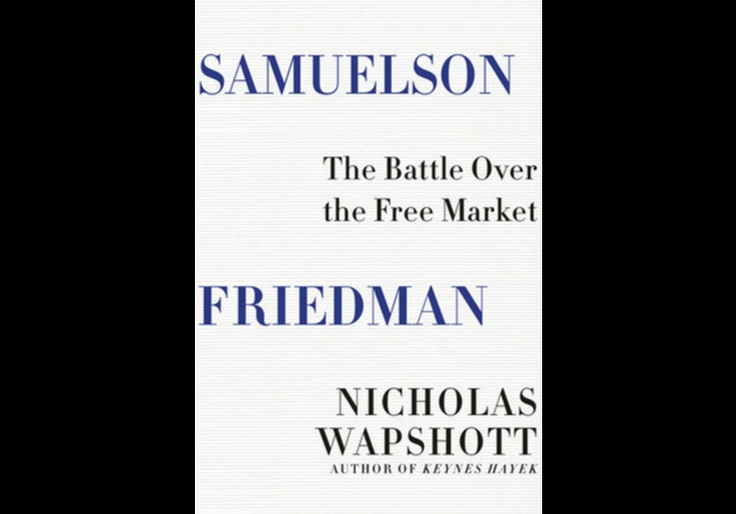In a 1988 address called "What Economists Do," Robert Lucas of the University of Chicago said that he and his fellow economists are actually storytellers. "I want to understand the connection between changes in the money supply and economic depressions," he said. But "the only really convincing way" to demonstrate that connection would be "to engineer a depression in the United States by manipulating the U.S. money supply."
Such an experiment would be impractical and inhumane. So economists are left with no choice. "We are storytellers," Lucas explained, "operating much of the time in the world of make believe."
Author Nicholas Wapshott tells the story of two of the greatest economic storytellers in Samuelson Friedman: The Battle Over the Free Market. If asked to name the two economists who dominated the last half of the 20th century, the most obvious are Paul Samuelson and Milton Friedman. They had dueling columns in Newsweek—Friedman on the right and Samuelson on the left.
Wapshott, the author of another head-to-head, Keynes Hayek, could have stuck to that dichotomy, but he wisely avoids relying on it. Debates in economics rarely come down to a strict left/right political divide.
One of the debates Wapshott spends the most time on is, rather fittingly, inflation. Friedman was convinced inflation is "always and everywhere a monetary phenomenon," meaning its root cause is always the quantity of money in the economy. Samuelson believed it to be more multicausal and had serious concerns about how to accurately measure the quantity of money in an economy at any given time. There’s really nothing particularly right-wing or left-wing about either of those views.
Truly, in the drama of late 20th century macroeconomics, Samuelson is the establishment. He wrote the book, simply titled Economics, that everyone else learned from. He was always hesitant about radical changes to the Keynesian consensus, even if empirical findings contradicted that consensus.
Friedman was the one seeking to overthrow the existing order. Wapshott calls him a "conservative economist" but also describes him as "insurgent," and even "revolutionary," without seeming to think much of the irony. Friedman was conservative only if "conservative" means nothing more than being associated with Republicans.
Dissenters from the Keynesian orthodoxy that Samuelson represented always have their eyes out for unfair treatment of their intellectual brethren in books. Libertarian economist Russ Roberts sums up the feeling in his article "The Economist as Scapegoat," when he writes of the odd phenomenon of left-wing commentators blaming Milton Friedman for everything that goes wrong in the economy even though Friedman’s ideas have rarely been enacted.
When reading Samuelson Friedman, you won’t get the feeling that Wapshott hates Friedman. He doesn’t seem to be pulling for a side, and you’ll likely come away with a more positive impression of the title economist you disagree with than you had before reading the book.
Samuelson and Friedman’s personal backgrounds are more similar than most would expect. They were both born Jewish, grew up relatively poor, and excelled in school to such an extent that they gained admission to the University of Chicago, where they knew each other as students. Their career trajectories exhibit American meritocracy at its best, and it’s impossible to come away from Wapshott’s treatment without respecting both men’s aptitude and perseverance.
Samuelson Friedman functions as an introductory history to American macroeconomics from roughly 1960-2010, and professors could do worse than assigning it to undergraduates for that purpose. Wapshott discusses Samuelson’s textbook and the changes it has undergone over time as the economic consensus shifts. He also examines Friedman’s major works, like A Monetary History of the United States (coauthored with Anna Schwartz) and his address to the American Economic Association, "The Role of Monetary Policy," where he lays out his monetarist vision of steadily growing the money supply at a moderate, fixed rate.
Wapshott has chapters on how Samuelson and Friedman influenced and reacted to Paul Volcker, Alan Greenspan, and Ben Bernanke. You’ll learn their dispositions toward every president from Kennedy to George W. Bush. He includes plenty of delightful historical tidbits, for example: "At a dinner thrown by Queen Elizabeth for Ronald Reagan on the royal yacht Britannia anchored off Santa Barbara in 1983, the monarch warmly greeted Friedman with, ‘I know you. Philip [the Duke of Edinburgh] is always watching you on the telly.’"
But in setting the book up as a rivalry, Wapshott feels he has to declare a winner in the last chapter. After some straining for contemporary relevance (e.g., "Could there have been a President Trump without Samuelson?"), he picks Samuelson. He shouldn’t have. Not because Samuelson doesn’t deserve it, but because the history of American macroeconomics doesn’t deserve it.
Look around and it’s evident that nobody has won the macroeconomic debates that matter. The Biden administration seems to be doing an experiment right now to see whether all of 20th century macroeconomics is wrong. Clearly Friedman would object to Biden’s big government proposals, but you won’t find a justification in Samuelson’s textbook for spending $6 trillion during an expansion with unemployment around 6 percent.
In telling the story of the storytellers, Wapshott reminds us how good we had it when Samuelson and Friedman were at the tops of their games. There was a Samuelson story and a Friedman story of the economy, and we could debate their merits and shortcomings. In the absence of those two great storytellers, or any apparent equivalent successors, we’re just winging it.
Samuelson Friedman: The Battle Over the Free Market
by Nicholas Wapshott
W.W. Norton, 384 pp., $28.95
